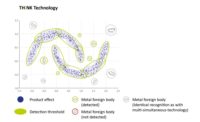Between the growing world population and rising standards of living, society and industry are facing ever-mounting challenges to combine profit with sustainability. Securing the food supply for a future in which the world population reaches 10 billion is one example of such a challenge. To meet these demands, food manufacturers and processors must increase productivity on the one hand, and reduce waste on the other. All the while, food production processes are under pressure from both consumers and retailers to ensure safety, efficiency, and regulatory compliance.
In addition to striving to ensure their own profitability, food manufacturers and processors must fulfill legal requirements, standards stipulated by retail chains, and customer expectations. Functional process technologies, such as foreign object detectors, are crucial to these aims.
Despite the breadth of technology available for foreign object detection, certain types of food products remain difficult to inspect via conventional methods. The reason for this is that some foods have high levels of product effect, which can interfere with metal detection.
Often the sensitivity of a metal detector is increased to compensate for product effect. This can however lead to a higher frequency of false rejects, thereby increasing product loss and food waste. X-ray-based product inspection systems are a possible alternative, but come with the disadvantage of being significantly more expensive than metal detectors.
New technologies combining metal detection and artificial intelligence provide a solution to these challenges. This white paper "How artificial intelligence contributes to sustainable and profitable food processing" examines the phenomenon of product effect, the problems it can cause, and why artificial intelligence offers an innovative and promising solution. The content includes the following points:
- What is artificial intelligence?
- What is product effect?
- What problems are caused by product effect?
- What advantages does AI offer for metal detection?
- What are the differences between conventional metal detection and metal detection with AI?
- How does the customer benefit from using AI in metal detection?
The white paper can be downloaded from the Sesotec website here.







